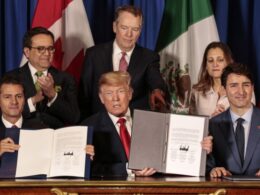Unlock the White House Watch newsletter for free
Your guide to what the 2024 US election means for Washington and the world
Investors fled US funds that hold riskier bonds and loans at a historic pace over the past week as fears that President Donald Trump’s tariffs will deal a heavy blow to the economy ricocheted across asset markets.
Investors yanked $9.6bn from US high-yield bond funds and $6.5bn from leveraged loan funds in the week to Wednesday, according to data provider LSEG Lipper. Both figures represent record outflows, according to JPMorgan data.
The big shift out of the junk bonds and risky loans comes after Trump’s announcement on April 2 of huge tariffs on many trading partners ignited a broad rush by investors into cash as they fret about risks to the economy. Riskier debt is exposed to economic ructions since borrowers are typically in a tougher financial position than those in high-grade markets.
US markets rallied strongly on Wednesday after Trump paused the “reciprocal tariffs” on many countries. But the sense of gloom returned on Thursday as investors continued worrying that 10 per cent universal tariffs, combined with 145 per cent duties on Chinese imports, could slow growth or even push the world’s biggest economy into recession.
“We do expect defaults to rise in the leveraged loan market. It gives investors, ourselves included, a lower tolerance for investing in riskier credits when there’s more nervousness after a shift in sentiment,” said David Forgash, who heads Pimco’s leveraged finance business.
A $6bn high-yield bond fund managed by State Street has fallen 2.9 per cent this week, leaving it on track for its worst weekly performance in almost three years, according to FactSet data
Fund managers and bankers have described the past week’s trading as relatively orderly, in contrast with the chaotic conditions in the credit market that contributed to the Federal Reserve intervening during the Covid-19 pandemic.
But the severity of the new tariffs, and the amount of uncertainty still hanging over the market, has caught some investors off guard.
“There had been a lot of foreshadowing that these tariffs would come,” said Matthew Bartolini, head of Americas ETF research at State Street Global Advisors. “The surprise was how onerous.”
Investors reacted to the tariffs by shifting from lower-rated bond funds and vehicles that hold leveraged loans, where credit is typically extended to lowly rated companies, to lower-risk fixed-income funds that hold assets such as government debt, inflation-protected securities and bonds with very short-term maturities, according to Morningstar analysts.
“ETFs built around credit risk got the cold shoulder,” Morningstar’s Bryan Armour and Ryan Jackson wrote in a note Wednesday.
Junk bond “spreads”, the premium that lower-rated borrowers pay on top of US government debt yields, have risen from about 2.9 percentage points in early January to more than 4.4 percentage points this week, the highest level seen since late 2023, according to data from Ice Bank of America data.
Credit health measures for US borrowers had shown signs of improving, rising in tandem with rising equity prices in 2023 and 2024, before this year’s downturn in markets, but elevated odds of a slowdown in US economic growth and the looming threat of a recession could reverse that trend.
Leverage ratios for loan issuers in the past three months of 2024 dropped to 4.78-times, the lowest in the post-pandemic period and far below the 7.71-times level from early 2021, according to JPMorgan.
“We believe credit metrics could improve further over the next quarter or so before a forecasted US economic slowdown weighs on fundamentals (in the second half of 2025),” JPMorgan analyst Nelson Jantzen said.
Source link









